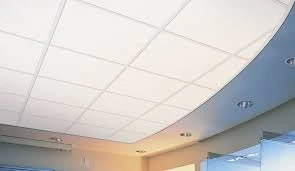Nov . 30, 2024 23:39 Back to list
drop ceiling metal grid
Understanding Drop Ceiling Metal Grids The Backbone of Suspended Ceilings
In the world of interior design and construction, aesthetics and functionality often overlap. One critical component that exemplifies this balance is the drop ceiling, particularly the metal grid system that supports it. A drop ceiling, also known as a suspended ceiling, provides an excellent solution for concealing structural elements, electrical wiring, and HVAC systems while enhancing the acoustic quality of a room. At the heart of this system is the metal grid, which plays an essential role in ensuring the ceiling's stability and durability.
What is a Drop Ceiling Metal Grid?
A drop ceiling metal grid consists of a framework made of metal channels, which are typically galvanized steel or aluminum. This grid forms the skeletal structure that supports the ceiling tiles, allowing them to drop from the actual ceiling. The metal grid system comes in various configurations and sizes, helping to create a versatile ceiling design.
Components of a Metal Grid System
A typical metal grid system consists of several key components
1. Main Runners These are the long metal beams that run the length of the room, spaced apart to hold the cross tees in place. 2. Cross Tees These shorter metal pieces connect the main runners and provide additional support for the ceiling tiles. They are usually available in different lengths, depending on the tile size and layout.
3. Wall Angles Installed along the perimeter of the room, these L-shaped metal pieces provide a finished edge for the grid and help support the hanging system from the main ceiling.
4. Hangers These are crucial for suspending the entire grid assembly from the structural ceiling. Hangers secure the main runners to the overhead structure, ensuring that the grid remains stable and level.
Installation Process
Installing a drop ceiling metal grid requires careful planning and precise execution. The process typically begins with measuring the room dimensions and planning the layout. Next, the wall angles are mounted, followed by the installation of the main runners, usually spaced 4 feet apart. Cross tees are then secured into place, forming a grid pattern that will support the ceiling tiles.
drop ceiling metal grid

Once the grid is in place, the final step involves inserting the ceiling tiles, which can be made from various materials such as acoustical tiles, drywall, or decorative panels. The installation process can be relatively simple with the right tools, making it a popular choice among DIY enthusiasts and professionals alike.
Advantages of Drop Ceiling Metal Grids
1. Accessibility One of the primary advantages of a drop ceiling metal grid is the accessibility it provides. The suspended ceiling allows easy access to plumbing, electrical wiring, and HVAC systems, making repairs and maintenance much more manageable.
2. Acoustic Benefits Many drop ceiling tiles are designed to absorb sound, making them ideal for office spaces, classrooms, and other environments where noise reduction is essential.
3. Aesthetics Metal grids offer a clean, modern look, and the wide variety of ceiling tile designs available ensures that designers can create a pleasing aesthetic that compliments any space.
4. Energy Efficiency By using acoustic tiles with insulation properties, drop ceilings can help improve a building's energy efficiency, reducing heating and cooling costs.
Considerations When Choosing a Metal Grid System
When selecting a drop ceiling metal grid system, there are several factors to consider. It's crucial to assess the room height, the type of ceiling tiles desired, and any specific acoustic or aesthetics requirements. Additionally, local building codes and regulations should be taken into account to ensure compliance.
Conclusion
The drop ceiling metal grid is an integral part of modern interior design and construction. Its functionality extends beyond mere support; it acts as a conduit for utility systems, contributes to sound management, and enhances the overall visual appeal of a space. With a wide range of designs and configurations available, drop ceilings are a practical solution for various applications, from commercial buildings to residential homes. Understanding the importance of a metal grid can empower designers and builders to make informed decisions that ultimately elevate the functionality and beauty of their spaces.
-
Quality Ceiling Trap Doors & Access Panels | Easy & Secure AccessNewsAug.30,2025
-
Durable Ceiling T Grid Systems | Easy InstallationNewsAug.29,2025
-
PVC Gypsum Ceiling: Durable, Laminated Tiles for Modern SpacesNewsAug.28,2025
-
Pvc Gypsum Ceiling Is DurableNewsAug.21,2025
-
Mineral Fiber Board Is DurableNewsAug.21,2025
-
Ceiling Tile Clip Reusable DesignNewsAug.21,2025







